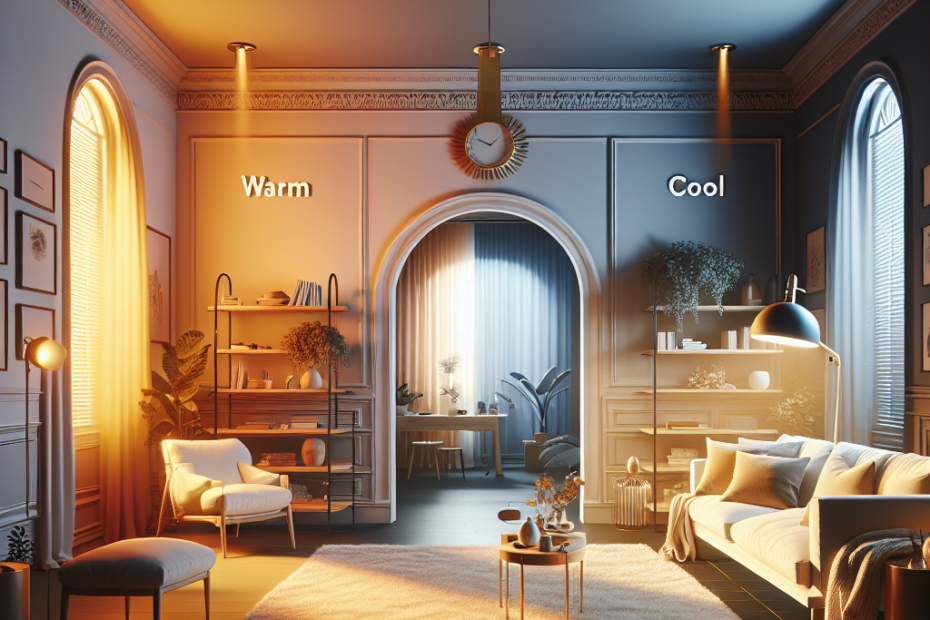When they envision a cozy home or an inviting space, they might not immediately think about the concept of color temperature in design. However, it plays a significant role in how people perceive their environment and their mood. Understanding the fundamentals of color temperature can assist them in making informed decisions that enhance their home’s aesthetic and functionality.
What is Color Temperature in Design?
Color temperature refers to the warmth or coolness of a light source, measured in Kelvins (K). Lower Kelvin values, such as 2000K-3000K, give off a warm, yellowish light, resembling a sunset or candlelight ambiance. Higher Kelvin values, like 5000K-6500K, emit a cool, blue-tinged light, akin to natural daylight.
Identifying the right balance between these extremes allows designers to create environments that cater to specific needs and moods. For example, warm light can evoke a sense of relaxation, perfect for living rooms, whereas cool light encourages focus, making it suitable for workspaces.
The Importance of Color Temperature in Home Design
Color temperature in design significantly impacts the overall feel of a space. Statistics reveal that 80% of people believe that lighting influences their mood, according to a study by Ipsos (source: Ipsos).
Good lighting can make a room appear larger, more inviting, or bring attention to specific architectural details. By understanding how color temperature works, homeowners and designers can optimize spaces for both functionality and comfort.
How to Choose the Right Color Temperature for Each Room
| Room | Recommended Color Temperature (Kelvin) | Effect |
|---|---|---|
| Living Room | 2700K – 3000K | Warm and Relaxing Atmosphere |
| Kitchen | 3000K – 4000K | Bright and Alert |
| Bedroom | 2700K – 3000K | Cozy and Calming Environment |
| Home Office | 4000K – 5000K | Energizing and Focus-Enhancing |
| Bathroom | 3000K – 5000K | Clear and Vibrant |
Balancing Natural and Artificial Light
They should consider how natural sunlight interacts with artificial light sources when planning a space. Windows and skylights introduce natural light, predominantly cooler in temperature. To create harmony, they might choose artificial lights that complement or contrast with this natural light, depending on the desired atmosphere.
Combining natural and artificial lighting effectively can enhance the architectural features of a room and promote the desired mood, ensuring that their spaces remain comfortable throughout the day and evening.
Using Color Temperature to Enhance Interior Design
Designers can use color temperature not just to illuminate a room but also to highlight specific decor elements. Warm lights can draw attention to wooden furniture and artwork, while cooler lights might be used to make spaces feel sleek and modern.
With the advancement of LED technology, adjustable color temperature lighting fixtures are gaining popularity, offering them flexibility in altering room ambiance with ease.
Key Takeaways
- Color temperature impacts the mood and functionality of home environments.
- Choosing the right Kelvin level for each room enhances comfort and efficiency.
- Balancing natural and artificial light creates harmonious living spaces.
- Adjustable lighting technology provides flexibility in interior design.
FAQ
-
What is color temperature?
Color temperature measures the warmth or coolness of a light source, expressed in Kelvins. Lower values appear warm, while higher values seem cool and bluish.
-
How does color temperature affect mood?
Warm lighting creates a cozy and relaxing ambiance, while cool lighting enhances focus and alertness.
-
What is the best color temperature for bedrooms?
Bedrooms benefit from warm lighting, typically between 2700K and 3000K, to create a calming and restful environment.
-
Can lighting affect how large a room feels?
Yes, the right color temperature combined with proper placement can make a room feel larger and more open.
-
What is the advantage of adjustable color temperature lighting?
Adjustable lighting allows users to modify the ambiance of any room to suit different activities or moods easily.
